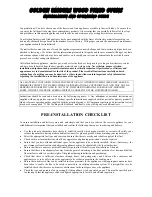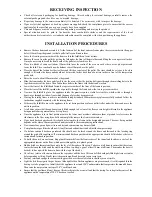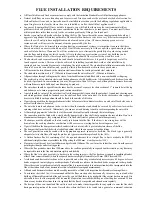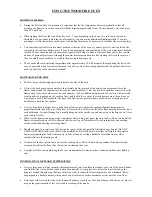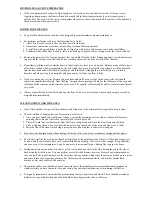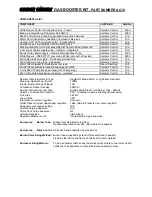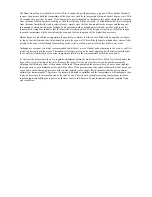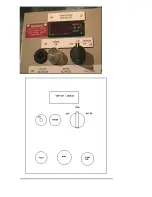
GOLDEN EMBERS WOOD FIRED OVENS
QUICK REFERENCE OPERATING MANUAL
(Refer to the detailed text of the product manuals and the Cooking with Fire book for more specific information)
THE SELECTION OF FIRE WOOD
CHARACTERISTICS OF WOOD
•
Wood is the hard, fibrous substance found beneath bark in the stems and branches of trees and shrubs. Practically
all commercial wood comes from trees. It is plentiful and replaceable.
•
Wood is made up of a number of substances. Cellulose constitutes about 50 percent of the wood by weight. Lignin
makes up about 23 to 33 percent of softwoods but only about 16 to 25 percent of hardwoods.
•
Ash-forming minerals are found in wood in very small quantities perhaps 0.1 to 3 percent by weight. Extractives
are not part of the wood structure, but they contribute colour and odour to the wood. Tree fragrance is marked in
some wood but essentially absent in many.
•
The classification of wood is related to the type of tree from which it is derived. Not all trees are used
commercially.
•
Trees are divided into two large classes: softwoods and hardwoods. These names can be somewhat misleading,
however, since there are hardwoods that are softer than some softwoods. Balsa, for example, is one of the softest
and lightest woods, but is classified as hardwood, Even within tree species hardness and other wood properties
vary, depending upon the conditions under which the tree was growing at the time the wood was formed.
•
The trees classified as softwoods have needle-like or scalelike leaves that, with a few exceptions, remain on the tree
all through the year. Hence softwood trees are sometimes called evergreens. The hardwoods are broad-leaved trees
and are frequently deciduous, shedding their leaves in winter.
•
Generally the wood nearest the bark of the tree, called sapwood, takes part in the life activity of the tree. The water,
minerals and materials needed for growth are moved through the sapwood of the tree. The central part of the tree,
which is usually darker, is called heartwood. Heartwood is denser and emits less smoke when burning, sapwood is
lighter and burns more fiercely, but can be smoky, particularly if not properly dried and cured.
•
Each species of wood has its own characteristics, which will set it apart from other woods and to determine its
suitability for certain uses.
•
Wood is made up of a number of substances. Cellulose constitutes about 50 percent of the wood by weight. Lignin
makes up about 23 to 33 percent of softwoods but only about 16 to 25 percent of hardwoods.
•
The lignin binds the wood fibres together. Fibres with the lignin removed, called de-lignified fibres, are mostly
cellulose. De-lignified fibres are used in papermaking. Lignin is an insoluble, intractable material that is difficult to
remove from the wood.
•
Hemicelluloses are associated with cellulose and make up about 15 to 30 percent of the wood by eight. Ash-
forming minerals are found in wood in very small quantities perhaps 0.1 to 3 percent by weight. Extractives are not
part of the wood structure, but they contribute colour and odour to the wood.
•
Tree fragrance is marked in some wood but essentially absent in many. Incense cedar and Port Oxford cedar, for
example, have a spicy odour. Unseasoned oak typically has a sour odour.
CHOOSING THE RIGHT FIRE-WOOD
•
You may use almost any species of hard or softwood (with the exception of pine and similar resinous timbers) to
fire your oven. Ideally use a wood which gives a good flame and burns to ash. Certain timbers can be blended for
their fragrance and aromatic flavouring properties.
•
Very hard timber burns slowly with a smaller flame and yields large amounts of coals which smoulder for extended
periods. Whilst these types of woods may well be the ideal woods for thermally inefficient ovens, they are not
particularly suited to thermally efficient ovens, such as the Golden Embers ovens. This type of wood will inevitably
cause excessive heating of the floor and a large amount of wood will need to be burned to obtain a good enough
flame to heat the cooking chamber properly. Although it may seem contradictory, softer woods which burn more
fiercely, such as wattle or sugar gum will be far more effective thermally efficient ovens with heat bank sub floors.
•
ALWAYS use well dried timber cut into split logs no thicker than a man's forearm, and approximately 200 –
400mm in length. It will save a lot of time and effort it you get the timer merchant to split the timber for you.
Содержание Wood Fired Ovens
Страница 14: ...GOLDEN EMBERS AC11 CLASS 1 GAS WOOD FIRE GAS TRAIN SCHEMATIC AND LEGEND ...
Страница 17: ......
Страница 18: ......

